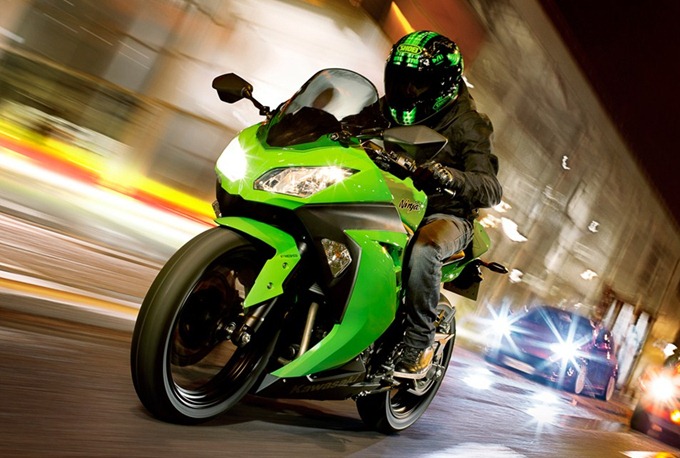Kawasaki Ninja 250R
The Kawasaki Ninja 250R
(previous generations had market-specific names) is a sport motorcycle
originally introduced by kawasaki motors in 1983. As the marque's
entry-level sport bike, it has proven to be a top seller, continuously
experiencing double-digit sales growth. It is a popular machine with
novices and experienced riders alike, renowned for its light handling,
good fuel economy, and comfortable riding posture. The motorcycle has
undergone few changes throughout its quarter-century lifetime, having
received only two substantial redesigns.
The fourth-generation model is marketed as
the Ninja 250R in all markets. The motorcycle is also referred to by its
platform designation, EX250, to which a generational suffix is
attached. In the US, previous generations of the bike (EX250-E/F/G/H)
were already being marketed as members of the "NINJA" family of
sportbike, while outside of the U.S. the bike was known variously as the
ZZR-250, ZX-250, or as the GPX-250R. One of the earliest generations,
the EX250-C, was given the name GPZ-250.
First generation (1983—1984)
First generation
EX250-C - Also known as the GPZ-250. Sold
only in its home market of japan, this earliest, belt-driven version was
first produced in 1983, and shares no commonality with later
generations.
Second generation (1986—1987)
Second generation
EX250-E - This model was sold as the Ninja 250R in Canada and the U.S.
between 1986 and 1987. It was known as the GPZ-250R elsewhere. When
originally introduced, it was more costly than the Honda Rebel, and
reviewers complained that while the 14,000 redline was nice, the engine
was slow to rev.
Third generation (1988—2007)
For
the 1988 model year, there were both cosmetic changes and changes in
engine tuning. While the bore and stroke, and other major engine
components, were unchanged, minor tuning adjustments were made. The
carburetor diameters were reduced 2 mm to 32 mm (1.3 in), the cylinder
compression ratio was increased from 12.0:1 to 12.4:1, and ignition
timing advance was increased. Reviewers were pleased to report that this
made the engine more free-revving, reaching the high 14,000 redline
more quickly, and the tested top speed increased by a few miles per
hour. The new, more fully-enclosed bodywork was complimented for being
stylish, at the time, and easily mistaken for the larger Ninja 750.
The third generation of production of the Ninja 250 encompassed three models:
- EX250-F
- The most widespread EX250 variant, the E model was completely
revamped and sold as the F model between 1988 and 2007 in the U.S.
Canada received the model between 1988 and 1999, and it was
available elsewhere as the GPX-250R as early as 1987.
- EX250-G
- Sold only in its home market of Japan, this version was known as
the GPX-250R-II. It sported dual front brakes, which slowed a
wider wheel and tire (110/80-16). All other parts were identical to
the -F model. It was sold after 1988.
- EX250-H - This model came to Canada as the Ninja 250R between 2000 and 2002, after which it received a new name: ZZR-250,
in line with the -H model's name elsewhere in the world, where it
had existed since 1992. This motorcycle has few parts in common
with the -F model, though it shares the same engine, albeit with
different casings. It sports a lateral aluminum frame, a different
fairing (designed to make it look sportier), larger 17" wheels, an
adjustable rear shock absorber, adjustable brake and clutch levers,
a smaller drive sprocket, computer-controlled timing advance, and a
revised electrical system.
Fourth generation (since 2008)
In 2008, Kawasaki gave the EX250 its most thorough modernization in many years. The EX250-J model is known as the
Ninja 250R worldwide, regardless of market.
Parts from the third generation are still found on the -J, but its
redesigned exterior panels bring the smallest Ninja's appearance out of
the '90s and into line with late-2000s sportbikes. The engine and
drivetrain retain 30% of the -F model's parts, according to Kawasaki
literature. The engine's compression and maximum torque have been
lowered to provide better midrange performance, where the motorcycle
spends most of its time. The redesign of the engine was a response to
frustration felt by new riders, according to Kawasaki, resulting in
improvements in engine response at low RPM, and making the bike smoother
and "much easier to ride." Though the previous generation Ninja 250 had
a peak power of 1 horsepower (0.75 kW) more, or peak engine power of
5 horsepower (3.7 kW) more according to official Kawasaki
specifications, according to testing by
Motorcycle Consumer News,
the new version's 20 or 30 percent increase in mid-range power allows
the bike to pull from 3,000 rpm where previously it had to be revved to
4,000. The U.S.-spec -J model uses dual carburetors like the -F model,
but the European-spec, Brazilian-spec and Thailand-spec model have a
fuel-injection system. The wheels were increased in size to 17 inches,
the front suspension was beefed up, and the brake rotors were replaced
with a larger "petal" design. A fuel gauge was put in place of the
previous model's temperature gauge, except on the Brazilian model. With
the additional and redesigned equipment, the EX250-J suffered a ten kilo
increase in wet weight over its predecessors.
With the arrival of the EX250-J, manufacturing continues to be located in Thailand.
Specification Of Ninja 250R 2008
Engine
|
Four-stroke, liquid-cooled, DOHC, parallel twin
|
Bore x Stroke
|
62.0 x 41.2mm
|
Carburetor
|
Keihin CVK30 x 2
|
Frame Type
|
Semi-double cradle, high-tensile steel
|
Rake/Trail
|
26 degrees / 3.2 in.
|
Front Tire Size
|
110/70-17
|
Front Suspension / Wheel Travel
|
37mm hydraulic telescopic fork / 4.7 in.
|
Rear Suspension / Wheel Travel
|
Bottom-Link UNI-TRAK® with 5-way adjustable preload / 5.1 in.
|
Front Brakes
|
Single 290mm hydraulic disc with two-piston caliper
|
Rear Brakes
|
Single 220mm petal disc with two-piston caliper
|


















